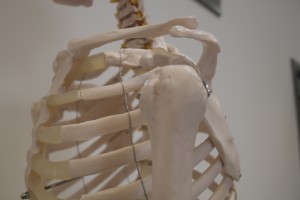Bursitis in the shoulder
Rehab training for the injury
Rehab 1 – Rehab 2 – Rehab 3 – Rehab 4
Description of bursitis in the shoulder
Bursitis in the shoulder is also called subacromial bursitis and is the most typical bursitis in the shoulder. It is an irritation and swelling of the bursa located between the upper shoulder blade and the clavicle, and then the tendon of the supraspinatus muscle, which is one of the shoulder stabilizers. The mucous membrane inflammation is more commonly caused by a nearby irritation (chemical infection) and is less likely an isolated injury. What typically infects the mucous membrane is inflammation or immune syndrome from the rotator cuff (shoulder stability muscles). Athletes over the age of 35 have a tendency towards developing calcium depots around the bursa, which may sometimes irritate the mucous membrane so that the condition develops.
Symptoms of bursitis in the shoulder
- Gradual pain at the shoulder joint.
- Pain in front of and above the shoulder joint.
- Pain in motion; even symptoms like rotator-cuff inflammation.
- Reduced mobility.
- Soreness over the shoulder joint.
Examinations for bursitis in the shoulder
- Analysis / inspection / palpation / movement test.
- Painful arch test. (60 ° / 70 ° – 120 °).
- Neck traction and compression test for pain to arm or hand.
Treatment of bursitis in the shoulder
- Rest in the acute phase – usually 2 days.
- Cryotherapy (ice massage).
- Thermal treatment (heat).
- NSAIDs (blocked by a doctor).
- Ultrasound (pulsating), 1 Mhz, 1 W cm2.
- AROM øvelser på 4. dagen (penduløvelser ect.).
- Massage of shoulder area.
- Rehab
- Traumeel. (2 tabl 3 g. daily for 9 days).
- Kinesiology tape like lymphatic tape.
- K-Laser.
Specifically, about rehab:
As soon as the first symptoms of the bursitis can be felt, rehab 2 rehabilitation must be started.
What the doctor can do:
Steroid injection in the mucous membrane. And possibly surgery if there are pronounced symptoms or failed attempts with conservative treatment. After surgery, the arm must be immobilized for 10 days before rehab is started.


Social Medier